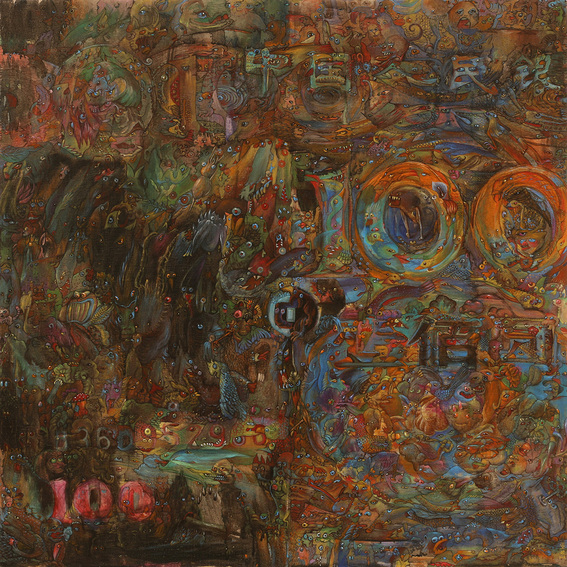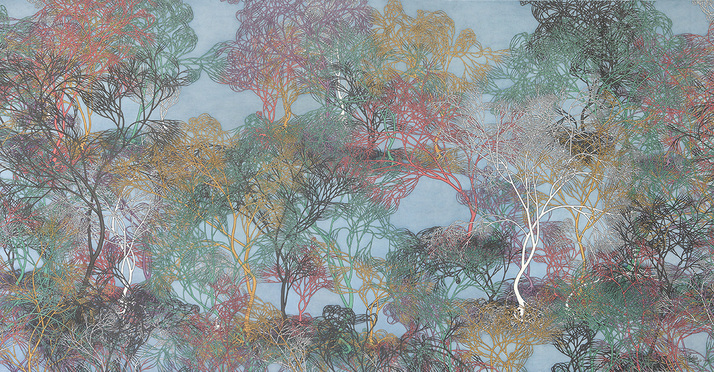-
From Current Issue
-
- Editor’s Letter Fire in the Heart
- Reviews I Gusti Ayu Kadek Murniasih
- Reviews 11th Seoul Mediacity Biennale: “One Escape at a Time”
- Dispatch Networked China
- One on One Monira Al Qadiri on Yukio Mishima
- Essays The rise of independent art spaces in pandemic-era Shanghai
- Features Tuan Andrew Nguyen
- Table of Contents
- Web Exclusives
- Archive
- Subscribe

R
E
V N
E
X
T
DONG YUAN, Four Seasons, 2015, acrylic and water color on canvas, 60 × 150 cm. Courtesy the artist and Chambers Fine Art, New York.
“Transitions” at Chambers Fine Art presented the work of three artists who explore themes of transformation in their art. While each worked with different artistic styles and mediums, there were shared elements in the works, such as undertones of political dissidence—indicative of the recent economic, cultural and political shifts in China where the artists work—and universally relatable concepts of change that come about due to the inevitable flow of life.
Using mainly acrylic and water, Dong Yuan illustrates hundreds of creatures creeping, crawling, dancing and flying across the canvas of Four Seasons (2015). Some are cartoon-like with round, exaggerated eyes; others appear as abstract shapes, and dotted throughout are figures rendered in a style that mimics traditional Chinese art. Though some of the characters share certain peculiarities, the execution of each one varies, as though multiple artists with varying styles contributed to the same composition. The evolving characteristics reflect transformations in the artist’s subconscious. In more explicit works such as Screaming – RMB #1 and #2 (both 2015), Yuan depicts these creatures in interpretations of the 100-renminbi note. According to the gallery’s literature, the piece is “a critique on an ‘ugly by-product’ of China’s fast-paced modernization, the writhing mass of creatures representing the greed-obsessed, ‘awful side of human nature.’” The undercurrent to modern life in Dong’s pieces appears to be absurdist, yet the work carries feelings of purpose, with the intertwined lives of the individuals suggesting that our collective movement through the world is influenced equally by each of us.
Echoing Dong’s concerns with China’s cultural flux, Lam Tung-pang examines Hong Kong and its role as a gateway through which art, culture and money flow in and out of the mainland. Lam’s rice paper paintings of Hong Kong’s currencies during and after British occupation elicit an awareness of the economic gravity held by his homeland, and posits that economic uncertainty can be a larger destabilizing factor than a troubling political climate, given that so much of Hong Kong’s culture revolves around its role as a regional financial hub. To reinforce the scales of impact of these economic forces as being both cultural and personal, the artist hid a note on the side of Effaced 2 (2014), the artist’s painting of a ten dollar bill, which reads, “Dear Mom, this is how I feel when I think about Hong Kong. Love, LT.” The artist speculated in a discussion with Chambers Fine Art that “after one hundred years, there may no longer be a Hong-Kong-dollar bill, and our identity will not be found anywhere,” a sentiment further reflected in the worn appearance of the bills he depicts. Lam also contributed pieces produced during Selling My Soul (2010), originally performed at the Tate Modern, London, in which he used rubber erasers with printed avatars of himself to erase charcoal marked on large paper strips. The rubber remnants left on the floor symbolized the destruction of the self, while the gesture created a void for growth in the charcoal. The bits of rubber that remained are displayed in a glass case at Chambers Fine Art, next to the paper strips. The work is illustrative of the value of personal evolution and sacrifice in the improvement of our collective futures.
Lao Tongli’s series also revolves around personal experiences of upheaval, and is the artist’s attempt to cope with the death of his father, who fought a long battle with heart disease. The fractal arterial patterns in the “Desire of Libido” series (2016–2017) and in Horizon – Positive Negative Zero Zero 03 (2017) mimic natural patterns found in the human body, root systems and rivers. This common visual arrangement is caused by a particle’s incentive to follow the most efficient trajectory. Lao expresses the spiritual affinity between humanity and nature, life and death, through his use of vivid colors and fine lines; the variation in color seems to represent different stages of a person’s life, with the lines indicating movement through each stage. The random spread of the fractals recall the connections that bond us to our living world, and suggests that even though death is the ultimate trajectory of life, one’s experiences along the way are vast, beautiful and valid.
Dong’s creatures, Lam’s avatars and the patterns created by Lao all convey deeper ideas of responsibility to the varying feelings we have within us during times of transformation. Though each piece may attempt to dissect change in different ways, they present tools to adapt and move through an ever-changing and transient world.
Installation view of “Transitions” at Chambers Fine Art, New York, 2017. Courtesy Chambers Fine Art.
“Transitions” is on view at Chambers Fine Art gallery in New York City, until September 2nd, 2017.
To read more of ArtAsiaPacific’s articles, visit our Digital Library.








